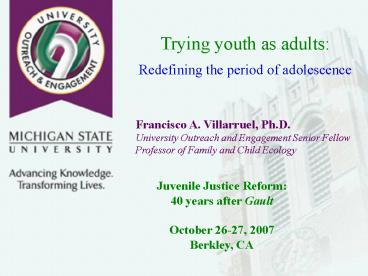Trying youth as adults: - PowerPoint PPT Presentation
1 / 14
Title:
Trying youth as adults:
Description:
Trying youth as adults: Redefining the period of adolescence. Francisco A. Villarruel, Ph.D. ... Adolescence or Youth? Adolescence. Introduced G. Stanly Hall ... – PowerPoint PPT presentation
Number of Views:149
Avg rating:3.0/5.0
Title: Trying youth as adults:
1
Trying youth as adults Redefining the period of
adolescence
Francisco A. Villarruel, Ph.D. University
Outreach and Engagement Senior Fellow Professor
of Family and Child Ecology
Juvenile Justice Reform 40 years after Gault
October 26-27, 2007 Berkley, CA
2
LanguageAdolescence or Youth?
- Adolescence
- Youth
- Introduced G. Stanly Hall (early 20th century)
- A period of turmoil and transition (13-18)
- A developmental period of transition in which
youth transition from dependence to
independenceto adulthood.
- Began being used in research in 1980s
- Generally refers to the 2nd decade of life, but
extended up to age 25 - Preferred because of the implications that this
is a life stage where tenants of adulthood exist
3
Current trend, future reality?
- By 2016, estimated that 1.4 million youth
currently aged 14 will be - Prison
- Homeless
- Dead
- Based on 2006 population estimates, this is
approximately 1 in 12 youth
4
Research summaries
- The majority of youth who enter adult courts
- Are not there for serious or violent crimes
(estimated to be over 200,000 per year) - Once an adult, always an adult
- On any given day, approximately 7,000 youth are
detained in jails with adults - Increased likelihood of sexual assault
victimization, physical abuse, psychological
distress
5
Challenges in understanding of the issue
- While statistics have long been available for
judicially waived cases, data collection efforts
have not kept pace with statutory changes
authorizing transfer via direct file and
statutory exclusion, so there is as yet no
national reporting program on cases removed by
exclusion or prosecutorial wavier (Bishop
Frazier, 2000, p. 229).
6
Contributing factor to underestimates
- States have no uniform reporting system to record
the number of juveniles tried as adults, because
definitions of juvenile defendants vary across
states and because state statutes that define
juvenile court jurisdiction change frequently
(Burgess-Proctor, Holtrop, Villarruel, 2006
Strom, Smith, Snyder, 1998).
7
Research summaries
- African-American and US Latino youth are more
likely to be tried as adults than non-Hispanic
white youth - In sum, data on the national level and for
specific jurisdictions throughout the country
demonstrate conclusively that youths of color are
transferred to adult courts far in excess of
their proportion in the population and in excess
of their proportion of the overall cases
processed by juvenile justice systems. (Bortner,
Zatz, Hawkins, 2000, p. 289)
8
(Un)intended consequences
- Voter disenfranchisement
- Economic costs of detention, reentry
- Family stability
- Mental health (individual and family)
- Employment, life wage earnings, and health care
costs
9
Impact of time in adult facilities
- Increased exposure to criminogenic surroundings,
thereby offering youth opportunities to gain
criminal training from incarcerated adults
(Myers, 2003 Podkopacz Feld, 1996). - higher rates of recidivism than their
non-transferred counterparts (Myers, 2003
Podkopacz Feld, 1996).
10
Impact of adult convictions
- problems associated with criminal conviction
(Bishop, 2000 Bishop et al., 1996 Gaarder
Belknap, 2002) - Redeemable to unsalvageable
- stigmatization
11
JJ v Adult facilitiesLoss of safety nets
- Deprived of opportunities for rehabilitation that
exist in juvenile facilities (Gaarder Belknap,
2002 Podkopacz Feld, 1996), - Fewer mental health services than they otherwise
would in a juvenile facility (Schindler
Arditti, 2001).
12
Waiver decisions
- Variable by state
- Generally based on statutory decisions as opposed
to an understanding of youth development (Ryan
Ziedenberg, 2007)
13
There is no yellow brick road
- Loss of funding opportunities for postsecondary
education - Loss of employment opportunities because of lack
of skill development - Impact on interpersonal relationships
- (Bishop, Fraizer, Lanza-Kaduce, White, 1999
- Fagan, 2006 Ruben, 2006)
14
So what????
- Research shows that waiver does little to enhance
community/public safety (Bishop, Fraizer,
Lanza-Kaduce, White, 1999 Fagan, 2006
MacAurther Foundation Research Network on
Adolescent Development, 2006)































